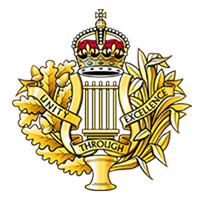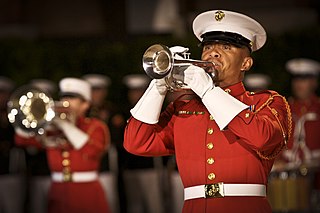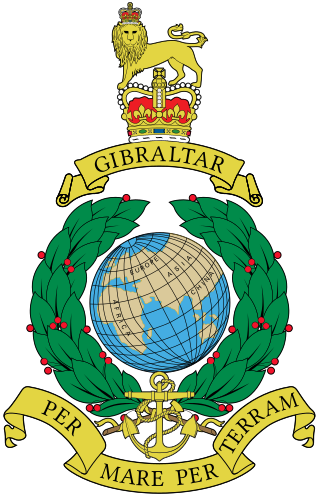Related Research Articles

A military band is a group of personnel that performs musical duties for military functions, usually for the armed forces. A typical military band consists mostly of wind and percussion instruments. The conductor of a band commonly bears the title of Bandmaster or Music director. Ottoman military bands are thought to be the oldest variety of military marching bands in the world, dating from the 13th century.

The Queen's Own Rifles of Canada is a Primary Reserve regiment of the Canadian Armed Forces, based in Toronto. The regiment is part of 4th Canadian Division's 32 Canadian Brigade Group. It is the only reserve regiment in Canada to currently have a parachute role. The regiment consists of the reserve battalion, the Regimental Association, and the Regimental Band and Bugles. The official abbreviation is The QOR of C, but the name is often abbreviated to QOR.

The Royal Corps of Army Music is a Corps of the British Army dedicated to the provision and promotion of military music.

Beating Retreat is a military ceremony dating to 17th-century England and was first used to recall nearby patrolling units to their castle.

The United States Marine Drum & Bugle Corps is the drum and bugle corps of the United States Marine Corps. The D&B is now the only full-time active duty drum corps in the United States Armed Forces. As one of many United States military bands, the United States Marine Drum & Bugle Corps consists of 80 active-duty Marines dressed in ceremonial red and white uniforms. The D&B performs martial and popular music.

A military tattoo is a performance of music or display of armed forces in general. The term comes from the early 17th-century Dutch phrase doe den tap toe, a signal sounded by drummers or trumpeters to instruct innkeepers near military garrisons to stop serving beer and for soldiers to return to their barracks and is unrelated to the Tahitian origins of an ink tattoo.

The Royal Marines Band Service is the musical wing of the Royal Navy and an independent element of the Royal Marines. It currently consists of five bands plus a training wing – the Royal Marines School of Music at HMS Nelson – and its headquarters is at HMS Excellent, Whale Island, Portsmouth.

A Corps of Drums, sometimes known as a Fife and Drum Corps, Fifes and Drums or simply Drums is an army unit used in several nations. Drummers were originally established in European armies to act as signallers. The major historical distinction between a military band and a corps of drums is that 'drummers' were not employed to play their instruments to entertain or delight, but instead to carry out a utilitarian battlefield role. This role is fulfilled by trumpeters or buglers in the cavalry and the artillery, who traditionally did not form into organised groups in the way that drummers did; therefore, a typical corps of drums would exist in the infantry arm.

The Royal Military College of Canada Bands is the official group of bands of the Royal Military College of Canada. The group is composed of four sections: the brass and reed, the pipes and drums, highland dancers, and choristers. Total band membership consists of 105 Officer Cadets from the college. Officer Cadets in the band practice three days a week in the morning on top of attending their individual full-time university programs.

A drum major in the military is the individual leading a military band or a field unit. It is an appointment, not a military rank. Military drum majors utilize a ceremonial mace for giving commands while marching. Many drum majors, particularly American- or British-influenced ones, wear a sash that can carry embroidered badges of their home unit and battle honors; a pair of ceremonial drum sticks are often attached.

Canadian military bands are a group of personnel in the Canadian Armed Forces (CAF) that performs musical duties for military functions. Military bands form a part of the Music Branch of the CAF, composed of six full-time professional Regular Force bands, 15 Regular Force voluntary bands, and 53 part-time reserve force bands. Bands of the Music Branch are often badged with the unit or Canadian Forces base insignia that they support.

For more than a century the Military Parade of Chile or Great Military Parade of Chile has been a tradition within the Independence Day holidays in Chile. It is held in Santiago, Chile's O'Higgins Park on September 19 yearly in honor of the Glories of the Chilean Army with a military parade involving not just the ground forces but by the rest of the Chilean Armed Forces: the Chilean Navy, the Chilean Air Force, and the Carabineros de Chile. It is also in honor of the anniversary of the formal inauguration on that day in 1810 of the First Government Junta, which witnessed the first military parade of the independent nation at the Plaza de Armas, Santiago. It is the final act of the national independence celebrations, which are broadcast through TV and the Internet and radio.

The Music of the Foreign Legion, formerly known as the Principal Music of the Foreign Legion is a Military band of the French Foreign Legion.

A mounted band is a military or civilian musical ensemble composed of musician playing their instruments while being mounted on an animal. The instrumentation of these bands are limited, with the musician having to play their instrument, as well as steer the animal to the designated location. Most mounted bands, therefore, use instruments that can easily be held, such as bugles, horns, and Fanfare trumpets. Timpani and glockenspiels are also a common feature, usually located at the head of a band. Although a band that is mounted on any member of the families Equidae and Camelidae are considered to be a mounted band, horses are most commonly used, mostly being employed in military bands in Europe, North and South America, and some parts of Asia.
The Band and Bugles of the Rifles is a military band serving as the regimental band for The Rifles, the sole rifle regiment and the largest in the British Army. It is the senior most of three bands in the regiment and is the only one that is part of the regular army. Uniquely, it employs bugles at its front, a tradition that goes back to the conflicts of the 18th century. Major Séan O’Neill is currently serving as the Director of Music (DOM) of the band and bugles. It is part of the Royal Corps of Army Music.

The British Columbia Regiment Band is one of many Canadian military bands in the Canadian province of British Columbia, serving as the official that serves as the official regimental band of The British Columbia Regiment, based out of Beatty Street Drill Hall in Vancouver. It is a voluntary band, which means that its band members are not composed of full-time professional musicians. The band currently provides musical support for the community in the Greater Vancouver metropolitan area.

Navy bands in Canada are part of the Royal Canadian Navy's command structure and overseen by the Music Branch of the Canadian Forces and the Directorate of History and Heritage of the Department of National Defence.
The 48th Highlanders of Canada Pipes and Drums is an authorized pipe band in the Canadian Forces and is currently located at Moss Park Armoury in Toronto, Ontario. The current pipe major is Master Warrant Officer Iain Lang, who is concurrently the official piper to the Lieutenant Governor of Ontario.

The military bands of the United Kingdom are musical units that serve for protocol and ceremonial duties as part of the British Armed Forces. They have been the basis and inspiration for many military bands in the former British Empire and the larger Commonwealth of Nations as well as musical organizations in other countries. Military musical units with British influence include United States military bands, the Japan Ground Self-Defense Force Music Corps and the Military Band of Athens. British military bands are controlled by the military music departments of the three services that compose the armed forces. These include the Royal Marines Band Service, the Royal Corps of Army Music, and the Royal Air Force Music Services. British style brass bands and carnival bands were then and are currently inspired by the British Armed Forces and its brass bands, especially of the Army's regular and reserve formations, as they follow a similar format as it relates to brass and percussion instruments.
References
- ↑ Vickers, Steve (2002). A History of Drum & Bugle Corps. Sights & Sounds, Incorporated. p. 2040. Retrieved 6 September 2021.
- ↑ Allen, Richard F. "Canadian military drum and bugle corps" (PDF). Drum Corps Xperience. pp. 367–372. Retrieved 6 September 2021.
- ↑ "Toronto Signals Regiment Drum Major". Drum Corps Planet Forums. 20 November 2007. Retrieved 6 September 2021.
- ↑ Lord, Cliff; Lord, Chris; Watson, Graham (24 February 2014). The Royal Corps of Signals: Unit Histories of the Corps (1920-2001) and Its Antecedents. Helion & Company Limited. p. 345. ISBN 9781874622925 . Retrieved 6 September 2021.
- ↑ "Toronto Signals". Optimists Alumni Drum Corps. Archived from the original on 1 January 2020. Retrieved 6 September 2021.
- ↑ "Toronto Signals Band". 32 Signal Regiment. Retrieved 6 September 2021.
- ↑ "The Elwood Hughes Trophy". The Warriors' Day Parade. Retrieved 6 September 2021.
- ↑ Leech, John (9 November 2019). "Toronto Signals Band Leads 32 Sig Regt to their Annual Remembrance Parade at York Cemetary in Toronto". CMCEN. Retrieved 6 September 2021.